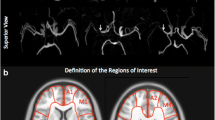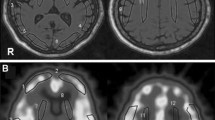Summary
Regional cerebral blood flow (rCBF), oxygen extraction fraction (rOEF), cerebral metabolic rate for oxygen (rCMRO2) and cerebral blood volume (rCBV) in nine cases of moyamoya disease in adults were studied with positron emission CT (PET) scan, using15O steady-state methods. Three cases showed ischaemic symptoms and the other six cases showed haemorrhagic symptoms. PET scan was performed during the chronic stage. Control data were obtained from eight normal volunteers. Regional cerebral blood flow and other physiological parameters in cerebral gray matter, white matter and basal ganglia were compared with normal controls.
All nine cases of Moyamoya disease showed decreased rCBF, though not significant, in cerebral gray matter, white matter and basal ganglia. Reduction of rCBF was significant in the cerebral cortex of six haemorrhagic cases. This significant decrease was considered to be due to diaschisis and also brain atrophy caused by the cerebral haemorrhage. There was a significant increase in rCBV in white matter of the both ischaemic and haemorrhagic cases. The calculated value of CBF/CBV is considered to be an index of perfusion pressure. This value was significantly decreased in all three regions, though rOEF was not significantly increased in moyamoya disease. Hence the cerebral circulation in adults with moyamoya disease appears to be characterized by a mild decrease in perfusion pressure and prolonged circulated time.
Similar content being viewed by others
References
Enevoldsen EM, Jensen FT (1978) Autoregulation and CO2 responses of cerebral blood flow in patients with acute severe head injury. J Neurosurg 48: 689–703
Gibbs JW, Wise RJS, Leenders KL, Jones T (1984) Evaluation of cerebral perfusion reserve in patients with carotid artery occlusion. Lancet 1: 310–314
Handa H, Yonekawa Y, Tanada Set al (1981) Natural course and dynamic CT scan in “moyamoya” disease in children. Annual report of research group about occlusive disease in Willis' circle. Japanese Welfare Ministry, pp 88–98
Hayashi H, Kobayashi M, Manda Y, Kawano H, Kabuto M (1985) Brain blood volume and blood flow in patients with plateau wares. J Neurosurg 63: 556–561
Lammertsma AA, Jones T (1983) Correction for the presence of intravascular oxygen-15 in the steady-state technique for measuring regional oxygen extraction ratio in the brain: 1. description of the method. J Cereb Blood Flow Metab 3: 416–424
Matsuda M, Yoneda S, Handa H, Gotoh H (1980) Cerebral hemodynamic changes during plateau waves in brain tumor patients. J Neurosurg 50: 483–488
Merlamed E, Lavy S, Bentin S, Cooper G, Rinot Y (1980) Reduction in regional blood flow during normal aging in man. Stroke 11: 31–34
Muizelaar JP, Lutz HA, Becker DP (1984) Effect of mannitol on ICP and CBF and correlation with pressure autoregulation in severely head-injured patients. J Neurosurg 61: 700–706
Paulson O, Lassen NA, Skinhoj E (1970) Regional cerebral blood flow in apoplexy without arterial occlusion. Neurology (Minneap) 20: 125–138
Senda M, Tamaki N, Yonekura Yet al (1985) Performance characteristics of Positologica 111: A newly designed whole-body multi-slice positron computed tomograph. J Comput Assist Tomogr 9: 940–946
Takeuchi S (1983) Cerebral hemodynamics in patients with “moyamoya” disease (part 1) A study of epicerebral microcirculation by fluorescein angiography. Neurol Med Chir (Tokyo) 23: 711–719
Taki W, Handa H, Yonekawa Yet al (1985) Cerebral blood volume blood flow and oxygen utilization in “moyamoya” disease. J Cereb Blood Flow Metab 5 [Suppl 1]: s439-s440
Author information
Authors and Affiliations
Rights and permissions
About this article
Cite this article
Taki, W., Yonekawa, Y., Kobayashi, A. et al. Cerebral circulation and metabolism in adults' Moyamoya disease-PET study. Acta neurochir 100, 150–154 (1989). https://doi.org/10.1007/BF01403603
Issue Date:
DOI: https://doi.org/10.1007/BF01403603




